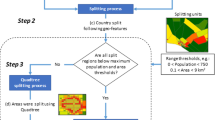Abstract
China still use sketch maps as control devices that guarantees consistency and accuracy of population counting in previous census. Although the rapid advancement of geospatial technologies provides many possible solutions of digital census mapping, existing researches do not answer which solution is suitable to China. Subject to many constraints originated from characteristics of China, a practical solution of census mapping based on remote sensing imagery and auxiliary geographic information was proposed and proved to be feasible through evaluation analysis and a three-stage pilot study. Imagery with 2.5 meters and higher resolution, innovative workflow of census areas delineation, easy-to-use census mapping software packages and training organization all together provide the all-around supports for the 2010 rounded census (the 6th census) mapping activities. A digital census geographic framework detailed at the level of enumeration area was established in the 2010 rounded census which fills in the gaps in the field of modern geospatial census in China. The spatially referenced digital census database, especially the detailed census units, is of great value in successive census, sampling survey and many other census-related fields. Future work including quality evaluation of census areas, census mapping solution in the Tibet Autonomous Region are also discussed.
Similar content being viewed by others
References
Alicia Bercovich, 2007. The use of handheld computers for interviews in population statistics: The 2007 population count for Brazil. Innovative Methodologies for Censuses in the New Millennium, a Satellite Meeting of the 56 session of the ISI, Southampton UK.
Beard Constance, DeGennaro Michael, Thompson William, 2011. Cartographic support for the 2010 decennial census of the United States. Cartography and Geographic Information Science, 38(3): 320–325. doi:10.1559/15230406382320
Chang Kang-tsung, 2010. Introduction to Geographic Information Systems (Fifth Edition). New York: McGraw-Hill.
Cheng Gang, Yao Jun, 2000. On delineation of census geographic areas. Population Journal, 3: 27–29. (in Chinese)
Department of Economic and Social Affairs Statistics Division, 2000. Handbook on Geographic Information Systems and Digital Mapping. New York: United Nations.
Department of Economic and Social Affairs Statistics Division, 2009. Handbook on Geospatial Infrastructure in Support of Census Activities. New York: United Nations.
Feng Liang, Liu Deqin, Ma Weijun, 2009. Technique studies on partition of census areas based on Voronoi diagrams. Science of Surveying and Mapping, 34(2): 97–99. (in Chinese)
Frederick R B, Leslie S G, 2003. Partnering for the people: Improving the US Census Bureau’s MAF/TIGER database. Photogrammetric Engineering & Remote Sensing, 69(10): 1119–1123.
Goodchild M F, 2007. Citizens as voluntary sensors: Spatial data infrastructure in the world of Web 2.0. International Journal of Spatial Data Infrastructures Research, 2: 24–32.
Li D R, Shao Z F, 2009. The new era for geo-information. Science in China Series F: Information Sciences, 52(7): 1233–1242. doi:10.1007/s11432-009-0122-9
Liu Deqin, Cheng Jia, Ma Weijun, 2011. Automatic division of census district based on constraint Delaunay triangulation. Science of Surveying and Mapping, 36(4): 134–135. (in Chinese)
Luo Bin, Li Hongsheng, Wang Yingjie et al., 2009. Design and implementation of web-based census cartography system. Journal of Geo-information Science, 11(6): 826–832. (in Chinese)
Ma Weijun, Liu Deqin, Li Yuqun et al., 2011. Research on the optimal spatial resolution of remote sensing image for census area division. Remote Sensing Information, (1): 77–81. (in Chinese)
Marizette de Meyer, 2004. The Feasibility of Using an Automatic Demarcation Process on Satellite Imagery to Identify Settlement Change for Census Purposes. South Africa: University of Pretoria.
National Bureau of Statistics of China, 2009. Pilot Plan of Enumeration Area Delineation and Census Mapping for the 6th Census of China, in press. (in Chinese)
Population Census Office, 1987. The Population Atlas of China. Hong Kong: Oxford University Press.
Robert W Marx, 1986. The TIGER system: Automating the geographic structure of the United States census. Government Publications Review, 13(2): 181–201. doi: 10.1016/0277-9390(86)90003-8
Sharthi Laldaparsad, 2007. A geo-referenced census frame of dwellings for the 2011 census of the Republic of South Africa. Innovative Methodologies for Censuses in the New Millennium, a Satellite Meeting of the 56 session of the ISI, Southampton UK.
Sun Cunqun, Zhou shunping, Yang Lin, 2010. Chinese geo-coding based on classification database of geographical names. Journal of Computer Applications, 30(7): 1953–1958. (in Chinese)
Sun Jingxin, Meng Qingpu, 1992. Census of 11 hundred millions—orgnization and implementation of census in 1990 in China. Population Research, (3): 1–15. (in Chinese)
The 5th National Census Office of China, 2000. Working Mannual of the the 5th Population Census. Beijing: China Statistics Press. (in Chinese)
Wang Yuanfei, Zhou Feng, Liu Zhiqiang et al., 2006. Component GIS for census in Pudong New Area. Journal of East China Normal University (Natural Science), 2: 27–32. (in Chinese)
Worrall L, 1994. Justifying investment in GIS: A local government perspective. International Journal of Geographical Information Systems, 8(6): 545–565. doi:10.1080/02693799408902021
Yu Zhuoyuan, Wang Yingjie, Su Ying et al., 2005. System design and construction of digital atlas of population of China. Geo-information Science, 7(2): 23–29. (in Chinese)
Author information
Authors and Affiliations
Corresponding author
Additional information
Foundation item: Under the auspices of National High Technology Research and Development Program of China (No. 2006AA120105), National Natural Science Foundation of China (No. 41001314), Youth Science Funds of State Key Laboratory of Resources and Environmental Information System (No. KA11040101), Chinese Academy of Sciences and National Science & Technology Pillar Program (No. 2012BAI32B07)
Rights and permissions
About this article
Cite this article
Wang, Y., Li, H., Yu, Z. et al. Approaches to census mapping: Chinese solution in 2010 rounded census. Chin. Geogr. Sci. 22, 356–366 (2012). https://doi.org/10.1007/s11769-012-0540-2
Received:
Accepted:
Published:
Issue Date:
DOI: https://doi.org/10.1007/s11769-012-0540-2




